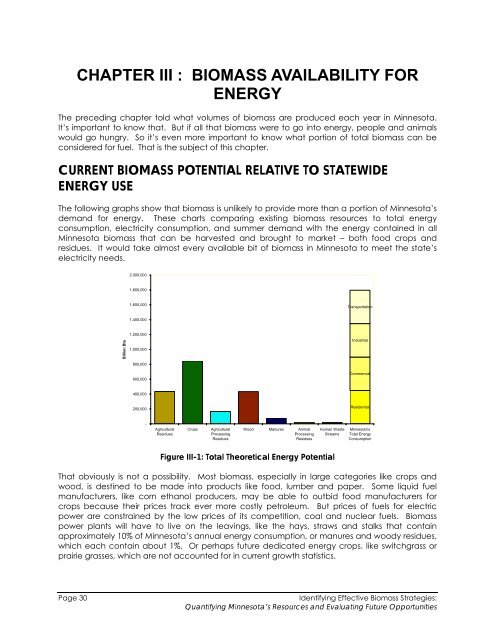Biomass Feasibility Project Final Report - Xcel Energy
Biomass Feasibility Project Final Report - Xcel Energy
Biomass Feasibility Project Final Report - Xcel Energy
Create successful ePaper yourself
Turn your PDF publications into a flip-book with our unique Google optimized e-Paper software.
CHAPTER III : BIOMASS AVAILABILITY FOR<br />
ENERGY<br />
The preceding chapter told what volumes of biomass are produced each year in Minnesota.<br />
It’s important to know that. But if all that biomass were to go into energy, people and animals<br />
would go hungry. So it’s even more important to know what portion of total biomass can be<br />
considered for fuel. That is the subject of this chapter.<br />
CURRENT BIOMASS POTENTIAL RELATIVE TO STATEWIDE<br />
ENERGY USE<br />
The following graphs show that biomass is unlikely to provide more than a portion of Minnesota’s<br />
demand for energy. These charts comparing existing biomass resources to total energy<br />
consumption, electricity consumption, and summer demand with the energy contained in all<br />
Minnesota biomass that can be harvested and brought to market – both food crops and<br />
residues. It would take almost every available bit of biomass in Minnesota to meet the state’s<br />
electricity needs.<br />
2,000,000<br />
1,800,000<br />
1,600,000<br />
Transportation<br />
1,400,000<br />
Billion Btu<br />
1,200,000<br />
1,000,000<br />
Industrial<br />
800,000<br />
600,000<br />
Commercial<br />
400,000<br />
200,000<br />
Residential<br />
-<br />
Agricultural<br />
Residues<br />
Crops<br />
Agricultural<br />
Processing<br />
Residues<br />
Wood Manures Animal<br />
Processing<br />
Residues<br />
Human Waste<br />
Streams<br />
Minnesota's<br />
Total <strong>Energy</strong><br />
Consumption<br />
Figure III-1: Total Theoretical <strong>Energy</strong> Potential<br />
That obviously is not a possibility. Most biomass, especially in large categories like crops and<br />
wood, is destined to be made into products like food, lumber and paper. Some liquid fuel<br />
manufacturers, like corn ethanol producers, may be able to outbid food manufacturers for<br />
crops because their prices track ever more costly petroleum. But prices of fuels for electric<br />
power are constrained by the low prices of its competition, coal and nuclear fuels. <strong>Biomass</strong><br />
power plants will have to live on the leavings, like the hays, straws and stalks that contain<br />
approximately 10% of Minnesota’s annual energy consumption, or manures and woody residues,<br />
which each contain about 1%. Or perhaps future dedicated energy crops, like switchgrass or<br />
prairie grasses, which are not accounted for in current growth statistics.<br />
Page 30<br />
Identifying Effective <strong>Biomass</strong> Strategies:<br />
Quantifying Minnesota’s Resources and Evaluating Future Opportunities

















